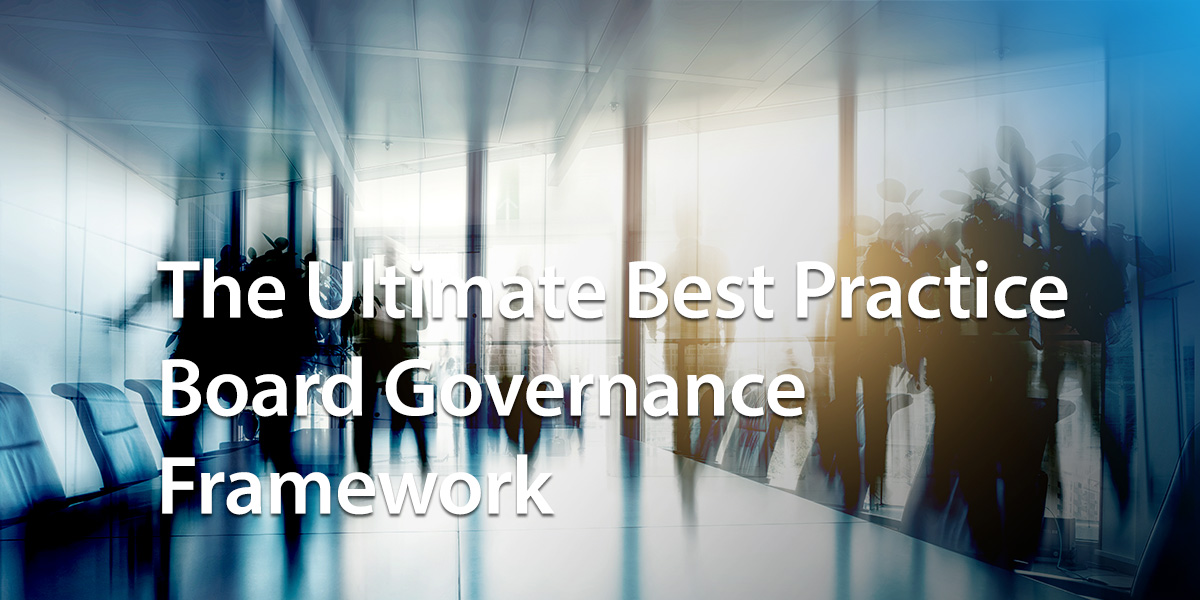Corporate governance is not the most thrilling topic. However, enterprise governance risk and compliance are crucial to companies of all shapes and sizes, whether for profit or not for profit. Quite simply, it’s vital to an organization’s long-term success. A robust corporate governance model ensures legal compliance, effective decision-making, greater transparency, and accountability. And without it, you run the risk of reputational damage. Check out the harm inflicted on Volkswagen’s brand in the wake of governance failures in the Dieselgate scandal. It took several years for VW to reestablish its climate change credentials. And it also resulted in billions of dollars in fines and damages.
The How, What, and Why
Today’s post walks you through everything you need to know about governance. We explore why it’s so critical. And we run through the four most common types of corporate boards.
Ready to get started? Let’s dive in.
What Is Enterprise Risk Management Governance?
Enterprise risk management governance is the process of setting up structures and procedures to provide oversight of organizations’ risk management activities.
And here’s the deal. Every organization is exposed to risk of some sort. It’s in the company’s best interests to safeguard assets, reputation, and value from potential losses, damage, or threats. Furthermore, organizations must ensure compliance with legal and regulatory standards. And performance is enhanced when leadership decision-making and problem-solving consider the opportunities and risks involved.
Many organizations have governing boards to support company leadership in overseeing risk. The governing board helps guide the overall running of the business by setting a long-term strategy. The board structure may vary depending on the nature of the business. However, governance is vital to creating compliant, ethical business practices and, ultimately, successful organizations.
What Are The 4 Governance Principles?
When it comes to effective corporate governance, there are four guiding principles:
Accountability
Board members are accountable for the organization’s operations and conduct. In partnership with executive management, the governing board has accountability for the corporate strategy and communicating important issues to shareholders.
Transparency
The board should provide timely, accurate information to shareholders and other stakeholders. This includes reporting on financial performance, risks, opportunities, or conflicts of interest.
Fairness
The board of directors should lead by example and treat all shareholders, stakeholders, employees, and vendors fairly and equitably.
Responsibility
Boards are responsible for overseeing corporate strategies and management. Board members must always act in the shareholders’ and company’s best interests. They are also responsible for appointing a chief executive officer.
These guiding principles are the yardstick for measuring the effectiveness of your chosen board structure.
What Are The Responsibilities Of Board Governance?
The primary focus of board governance is to help the organization achieve its business goals, create value, and respond to changing environments. Boards are responsible for ensuring that companies are well-run, accountable, and transparent.
Let’s break down what that means in practice. Board members’ responsibilities include the following:
- Safeguarding the organization’s financial stability
- Reviewing and approving the strategic plan
- Monitoring and evaluating the performance of the organization and its executive team
- Establishing and maintaining ethical standards and compliance processes
- Recruitment, appointment, and oversight of the CEO
- Developing and supporting strong relationships with major shareholders, stakeholders, regulators, employees, and customers
- Ensuring a diverse group of board members with representation across different cultures, genders, and backgrounds
- Advising and supporting the CEO and executives in making important decisions and developing business strategies
What Is Good Board Governance?
The likes of McKinsey and Harvard Business Review have researched what makes for good board governance. Reflecting on the latest best practice, here’s our take on the vital characteristics of an effective board structure.
Board Composition
It’s crucial to get the right mix of people. Ideally, you want a diverse range of skills, experience, and backgrounds. That way, the board can effectively fulfill its responsibilities and add value to the organization.
Clear Roles And Responsibilities
Board members must clearly understand their obligations and those of the CEO and leadership team. The organization’s purpose, mission, and values are well understood, and the board ensures close alignment with company strategies.
Policy Oversight
Board processes are in place to give the board oversight of key policies and procedures, including ethics and compliance. Risks are identified, and opportunities are seized after thoughtful evaluation.
High-Impact Board Meetings
Board meetings are efficient and effective and focus on strategic issues. The board receives timely, accurate data to support its decision-making responsibilities. Board members ask insightful questions and are prepared to challenge the status quo.
Teamwork
Board members, the CEO, and company executives work well together as a team. There’s mutual respect, trust, and a shared commitment to achieving company objectives.
Review
Good board governance involves self-reflection and review. Board members understand that there’s always room for improvement. The board regularly evaluates its performance and effectiveness and takes steps to improve. It also keeps a close watch on the performance of individual company directors and executives.
What Good Corporate Governance Is Not
Effective board governance is not about micromanagement. Boards shouldn’t get involved in day-to-day operations. With the exception of an executive board – more on that later – daily operations are strictly within the remit of company management.
Remember, the board’s primary focus is strategy and the long-term future of the company. Boards shouldn’t concern themselves with the minutiae of staff activities or find themselves line managing directors.
What Are The 4 Models Of Governance?
There are several board governance models available. The final choice depends on the type of organization and its requirements. For example, public companies may choose a different option to not-for-profits. And small startups often go for a working board setup.
Here’s a run-through of the four most popular corporate governance models.
Governance Board
The governance board provides leadership and direction to company management. These boards have a responsibility towards shareholders and are driven by their best interests.
Working Board
A working board is most often seen in smaller organizations or startups. Membership comprises the board of directors plus employees, usually senior leaders.
Advisory Board
An advisory board provides external expert advice to management and the main board. Often advisory boards are set up to offer guidance on a specific subject. For example, an organization contemplating a major restructuring might convene an HR advisory board to provide specialist advice.
Executive Board
Also called a managing board, these boards take responsibility for day-to-day operations. An executive board also makes company decisions.
Other Types Of Boards
While the four models discussed are the most common types of board governance, there are other options. These include the following:
Fundraising board: No surprises here. As the name suggests, fundraising boards are responsible for raising money and providing other resources the organization needs.
Policy board: This specialist board develops policies, rules, and processes for management to implement in the organization.
Cortex board: This board focuses on accountability to the community and the organization’s value to a broader group of stakeholders.
How Do You Create A Corporate Governance Structure?
Careful planning is needed to ensure you get the accountability, compliance, and effective decision-making your organization needs. Creating a corporate governance structure is much easier if you break it up into the following manageable steps:
- Define the organization’s objectives: Identify the mission, vision, and values of the organization. This first step sets out the foundation for the entire governance structure.
- Identify stakeholders: Think about all the internal ones, including employees, leaders, and shareholders. Next, consider the external stakeholders, such as customers, suppliers, and communities. Understanding their interests will help ensure your governance structure satisfies their needs.
- Appoint a board of directors: Governance is a huge responsibility, and you need a diverse mix of expertise, experience, and backgrounds. Some board members may be retired industry professionals. Other members may have specialist legal, HR, or financial knowledge. Be sure to define board members’ roles and responsibilities clearly. And ensure every board member knows what they are signing up for.
- Select an appropriate board governance model: Use our discussion on governance models to help you select the perfect model for your organization. And remember to consider the compliance and regulatory framework affecting your company. You want to ensure board governance complies with relevant federal and state laws.
- Develop governance policies and processes: These rules set out how decisions are made and conflicts of interest are managed. You may also want to develop a board members’ code of conduct and policies for handling compliance, ethics, and risks, including crisis management.
- Review and evaluate: Governance isn’t a one-off exercise. It’s an ongoing process. Regularly review and assess the board governance structure. You want to ensure it’s flexible and adaptable so that you can quickly respond to changing circumstances.
How Can Board Software Support Corporate Governance?
While there’s no substitute for sound policies and processes, good administration is also critical. That’s where board governance software comes in handy. Technology plays a massive part in reducing the admin burden. It helps make the lives of company administrators, directors, and boards that bit simpler. And that means companies’ leaders can get on with the crucial job of governing.
Here are some of the tasks technology can streamline:
- Automated board meeting schedules
- Agenda builder – create timed agendas and assign ownership of items
- Centralized storage of board papers – meeting agendas, reports, and minutes are located in a central, searchable hub
- In-meeting minute-taking
- Document collaboration – real-time collaboration and commenting on documents and reports
- Secure voting on resolutions
- Task tracking – assign and track the board of directors tasks and meeting action points
Best of all, board software goes a long way to ensuring governance is transparent, efficient, and accountable.
Corporate Governance Models: Quick Recap
Today’s post has covered the latest best practices in board governance. Here’s a handy summary of what you need to know.
- Board governance ensures that organizations are compliant, transparent and accountable to shareholders.
- There are four main types of corporate boards: governance, advisory, executive, and working board.
- Board responsibilities vary but include financial stability, compliance, risk management, and overseeing corporate strategies.
- Effective governance means a diverse board of directors is in place. Roles and responsibilities are clearly defined. And robust governance arrangements are set up.
- Board governance software streamlines administration and supports effective governance.
- Use our six-step process to create a best-practice corporate governance structure.
About MyHub
We are a leading provider of cloud intranet software. Simple to use and manage, our platform is designed by experts for non-experts. And it comes pre-loaded with all the tools you need to support corporate governance. In-built communication, automated workflows, document storage, and collaboration tools will streamline the work of any board of directors. Even better, MyHub’s intranets make for more efficient and effective work across the entire organization.
Find out more with a free demo or 14-day trial.











0 Comments